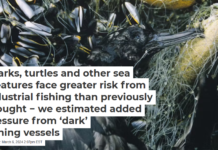
By Kevin Trenberth, National Center for Atmospheric Research
Many people around the world, in certain locations, have asked, “where is global warming?” This is because they have experienced very cold wintry conditions and weird weather that they do not associate with a warming climate. Yet global warming and climate change may very well be factors in what they are experiencing.
Perhaps the first case in point was the northern winter of 2009-10 which was exceptionally cold in Europe. Yet 2009-10 was one of the warmest winters globally it was very warm in the northern half of North America, for instance. This picked-upon feeling was furthered in 2010-11 and 2012-13 winters, which again were very cold in Europe but not elsewhere. Why is that and what is causing it?
Then this past winter of 2013-14 it was the turn of the eastern half of the United States to suffer through unusually cold and snowy conditions. At the same time there were record high temperatures in Alaska and along the West Coast as a record-breaking drought developed in California. It was also exceptionally wet in southern England and widespread flooding developed.
The fact that the exceptionally cold spots were localized about 2% of the globe while quite warm conditions existed elsewhere, and especially in the Arctic, provides a clue. Atmospheric circulation via waves in the jet stream plays a role.
El Niño
The weather is never normal. Instead, it fluctuates between times of cooler conditions and warmer conditions as weather systems migrate across the globe, accompanied by rain or snow.
Sometimes large-scale waves in the atmosphere get stuck and so instead of varying weather, the weather repeats over and over again, as cold outbreaks recur in the same spots while drought develops somewhere else and floods prevail elsewhere. This is what has happened in the US last winter, where the East Coast shivered through a polar vortex while the West Coast suffered from a long drought that continued through the summer.
It is not new – the theory behind this was developed in the 1980s. A key region, it turns out, is the tropical Pacific Ocean and the El Niño phenomenon. Interactions between the atmosphere and ocean in the tropical Pacific allow an El Niño event to develop over a period of a year to 18 months. This leads to a warming of the central and eastern tropical Pacific.
This changes the distribution of tropical storms, from hurricanes to thunderstorms, which in turn leads to large-scale waves in the atmosphere, altering the jet stream and storm tracks. Usually these are in the Pacific-rim countries but the waves can extend farther downstream across the Americas into the Atlantic. Scientists call these links “teleconnections”.
What does this mean for climate change?
A recent paper I worked on applies these ideas to the so-called hiatus in global warming. Global mean temperatures climbed steadily from the 1970s until 1998, but have stagnated since then.

Trenberth et al (2014) Nature Climate Change
This has been picked up by climate change deniers to suggest that global warming is not what scientists have said. However, we suggest on our paper that global warming continues but is manifested in different ways. Focusing on the tropical Pacific as a core region for major changes in rainfall and a source of continental-scale waves in the atmosphere shows how regional cold spots can happen.
We highlight that cold winters in Europe go along with a warm Arctic. In fact it is likely the Arctic has warmed more than otherwise expected owing to the wave patterns that have occurred over the past decade. So “Arctic amplification” is a consequence, not a cause of the increased waves, as has been suggested in the past.

NASA
Storing heat in the ocean
We can also use this model to explain patterns of change in Antarctic sea ice: reductions in the Antarctic Peninsula area while there have been expansions in the South Pacific. The connections extend from the tropical Pacific to the Atlantic in both hemispheres in winter: to the North Atlantic and Europe in northern winter, and across South America in southern winter, and to the southern oceans.
These changes in the atmosphere cause changes in the ocean and have led to heat being stored deeper than 700m in the ocean. while heat has also been carried down deeper in the subtropical Pacific, away from the surface.
The largest region of the planet that has not warmed in the 2000s is the eastern half of the Pacific Ocean. The planet is warming, but heat is effectively being dumped deeper in the ocean.
Pacific Decadal Variability
Scientists have documented many aspects of the variability I’ve described, and are now refocused on the Pacific Decadal Oscillation, as it has been called, as a key to these large-scale patterns of change.

Kevin Trenberth, Author provided
This is a natural phenomenon; it has gone on for centuries, but it might be being altered by climate change. Understanding and predicting its behavior may help provide better information for those affected by the unusual extremes that have caused so much damage.
![]()
Kevin Trenberth does not work for, consult to, own shares in or receive funding from any company or organisation that would benefit from this article, and has no relevant affiliations.
This article was originally published on The Conversation.
Read the original article.




















